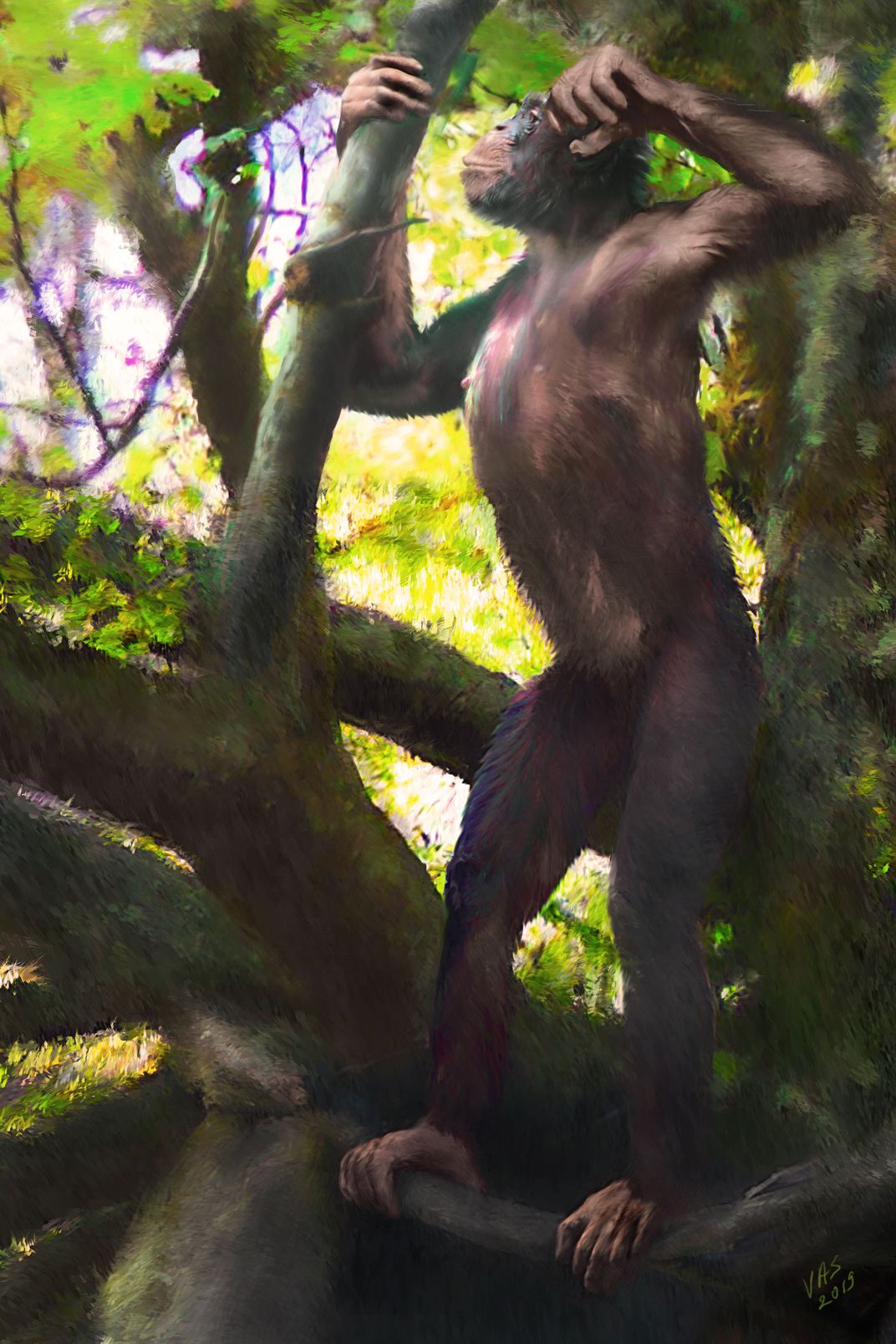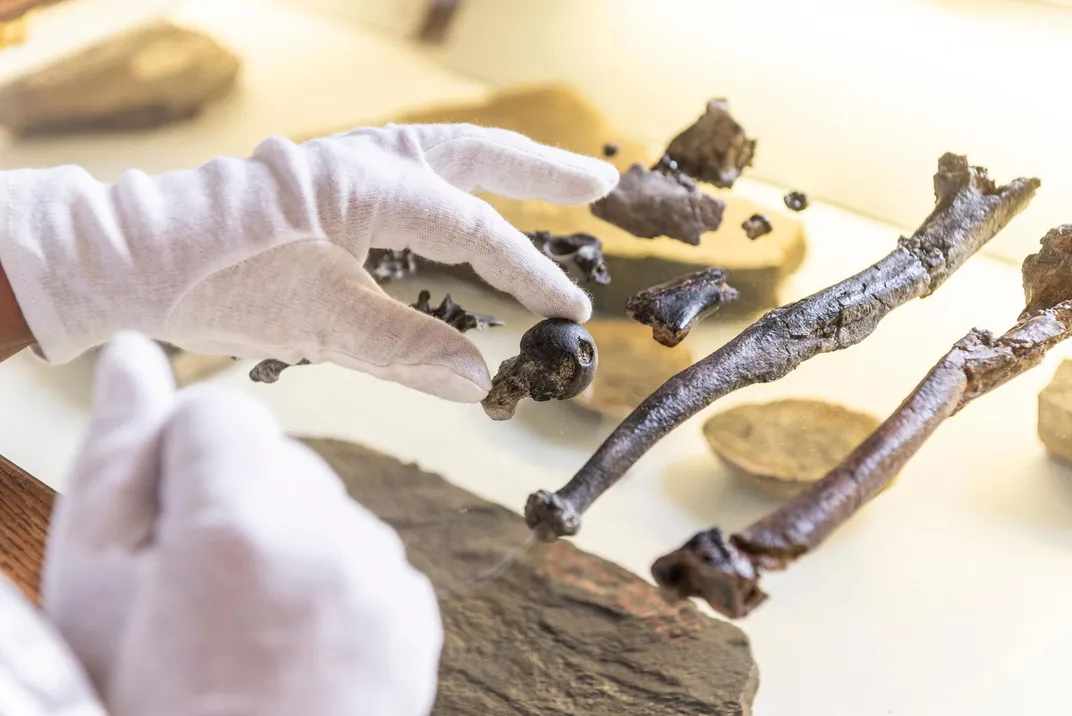New Ancient Ape Species Rewrites the Story of Bipedalism
Danuvius guggenmosi, a “totally new and different” species of ape, would have moved through the trees using its forelimbs and hindlimbs equally
:focal(809x695:810x696)/https://tf-cmsv2-smithsonianmag-media.s3.amazonaws.com/filer/cb/92/cb92c4ba-cb46-4ccf-b78a-4298c4facf84/ape-bones.jpg)
The picture is on T-shirts, coffee mugs and bumper stickers: the ubiquitous but misinformed image of the evolution of humankind. A knuckle-walking ape rouses himself to stand on two feet, and over a 25-million-year “March of Progress,” he becomes a modern man.
Most paleoanthropologists will tell you that this version of evolution is oversimplified, misleading or just plain wrong. The theory that the last common ancestor of humans and apes walked on its knuckles like a chimpanzee is not supported by the fossil record, although it has seen popularity in scientific discourse. David Begun, a paleoanthropologist at the University of Toronto, used to be an outspoken proponent of the knuckle-walking hypothesis, until he was asked to consult on a newly discovered fossil that would challenge his assumptions about early hominid locomotion.
When Madelaine Böhme, a researcher at the University of Tübingen in Germany, unearthed the partial skeleton of an ancient ape at the Hammerschmiede clay pit in Bavaria, she knew she was looking at something special. Compared to fragments, an intact partial skeleton can tell paleoanthropologists about a creature’s body proportions and how its anatomy might have functioned. A relative newcomer to the field and a paleoclimatologist by trade, Böhme enlisted Begun’s expertise in analyzing the fossil ape.
Böhme and colleagues determined that the bones they found came from a dryopithecine ape, an extinct ancestor of humans and great apes that once lived in the Miocene epoch. The fossils are approximately 11.6 million years old and came from at least four individual apes, including one partial skeleton. The team described the newfound ancestor, named Danuvius guggenmosi, in a study published today in Nature.

D. guggenmosi was likely a small primate about the size of baboon, with long arms like a bonobo. The creature had flexible elbows and strong hands capable of grasping, which suggests that it could have swung from tree to tree like a modern great ape. But the similarities with known apes stop there. The animal’s lower limbs have much more in common with human anatomy. With extended hips and knees, D. guggenmosi was capable of standing with a straighter posture than that of living African apes, and its knees and ankles were adapted to bear weight. The animal’s locomotion would have therefore shared similarities with both human and ape movement, and D. guggenmosi may have been able to navigate the forest by swinging from tree limbs and walking on two legs.
“There is no reason to think it would not have used all four limbs when that made sense, for example, on smaller branches where balance was an issue,” Begun says. “But it was also capable of both chimp-like suspension and unassisted bipedalism.”
This hybrid form of locomotion, which Böhme and colleagues dubbed “extended limb clambering,” was previously unheard of. Begun says before this discovery, scientists in the field used models of motion employed by living quadruped primates to inform how our early ancestors may have moved. “Here, we have something that doesn't exist today,” he says. “It's totally new and different, and you couldn't imagine it. It would have been silly to even suggest it unless you found fossils that told you that there was an animal like this.”
Unlike suspensory great apes that favor their forelimbs and bipedal hominins which prefer their hindlimbs, the anatomy of D. guggenmosi indicates that the ancient primate used both sets of limbs equally. The curvature of the big toe suggests that this animal would have been able to walk flat-footed on branches, using its longest toe to grasp and balance.
“Our last common ancestor with great apes doesn’t look like a chimp or any living great ape—he may have looked like Danuvius,” Böhme says.

D. guggenmosi puts bipedality on the evolutionary timeline far earlier than scientists previously expected. Jeremy DeSilva, a paleoanthropologist who reviewed the study for Nature, says while this discovery sheds some light on how hominids began to walk on two feet, it also raises new questions about the evolution of locomotion. Rather than humans evolving to become bipedal after splitting from a quadruped ancestor, the great apes must have evolved from a creature with bipedal capabilities.
“Given what we know about the relationships between humans and the African great apes, then gorillas and chimpanzees would have had to have independently evolved knuckle-walking. That would have happened twice,” DeSilva says. “That is unsettling. It's disruptive to what we once thought.”
Böhme says it is also worth noting that D. guggenmosi was found in Europe, far from where most people imagine ancient apes lived. The narrative of human evolution is typically set on the African stage, but before early humans evolved, some of their primate relatives were living in forests that stretched across the Mediterranean. “We have to keep in mind that a big part of human history or human early evolution was not an African story,” Böhme says.
Another mysterious part of the puzzle, DeSilva says, is that the European apes completely disappear a few million years after D. guggenmosi. And another couple million years after that, scientists start to see evidence of early human development in Africa. But there’s a huge gap in the fossil record between D. guggenmosi and the next partial skeleton in the human family, Ardipithecus ramidus.
“We've got these bookends with Danuvius and Ardipithecus, and then the in-betweens are now giant question marks,” DeSilva says. “To a scientist, that’s not discouraging. It’s exciting.”
/https://tf-cmsv2-smithsonianmag-media.s3.amazonaws.com/accounts/headshot/Daily-Staff-Photos-by-Noah-Frick-Alofs-3620-317x475.jpg)
/https://tf-cmsv2-smithsonianmag-media.s3.amazonaws.com/accounts/headshot/Daily-Staff-Photos-by-Noah-Frick-Alofs-3620-317x475.jpg)